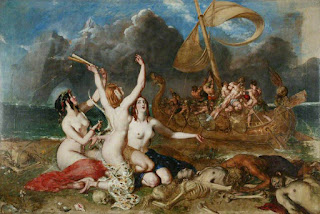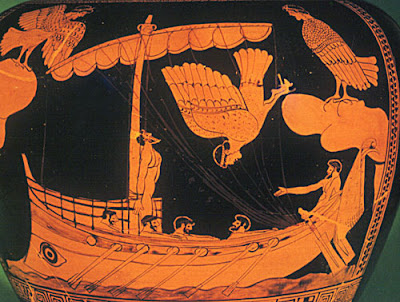‘Come closer, famous Odysseus—Achaea’s
pride and glory—
moor your ship on our coast so
you can hear our song!
Never has any sailor passed
our shores in his black craft
until he has heard the honeyed
voices pouring from our lips,
and once he hears to his
heart’s content sails on, a wiser man.
We know all the pains that
Achaeans and Trojans once endured
on the spreading plain of Troy
when the gods willed it so—
all that comes to pass on the
fertile earth, we know it all!’
So they sent their ravishing voices out across the air
and the heart inside me throbbed to listen longer.
 |
| "Song of the Sirens" Leslie Peterson Sapp 16"x20" Collage painting on panel |
and the heart inside me throbbed to listen longer.
Although this is one of the
most well known episodes of The Odyssey, it is surprisingly short. If you want
to know the context of the story and some analysis, you can visit cliffnotes.com here.
 |
| "Ulysse et les sirènes" Pablo Picasso, 1947 |
The goddess Circe, Odysseus’
sometime seductress, sometime ally warns him of the dangers of passing the
Island of the Sirens.
The high, thrilling song of
the Sirens will transfix him,
lolling there in their meadow,
round them heaps of corpses,
rotting away, rags of skin
shriveling on their bones …
Race straight past that coast!
She gives him a plan to safely
pass, knowing that Odysseus himself will not be able to resist his own curiosity:
Soften some beeswax
and stop your shipmates’ ears
so none can hear,
none of the crew, but if you
are bent on hearing,
have them tie you hand and
foot in the swift ship,
erect at the mast-block,
lashed by ropes to the mast
so you can hear the Sirens’
song to your heart’s content.
But if you plead, commanding
your men to set you free,
then they must lash you
faster, rope on rope.
In the Victorian era, there
was really only one way that a painter could depict nudity or sexual themes,
and that was to base the painting on some kind of pre-Christian mythology. So
this story of the Sirens was used again and again to show The Sirens as sexual
temptresses, bent on snaring innocent seafaring men to their death.
 |
| "La Sirena" Giulio Aristide Sartorio, 1893 |
 |
| "The Sirens and Ulysses" William Etty, 1837 |
 |
| "The Sirens and Ulysses" Herbert James Draper, 1909 |
The theme of woman as
temptress is one that inspired Max Beckmann again and again. (He is one of my favorite painters, but sometimes his obsession with this is something I have to look past!) His painting gave
me the idea of placing Odysseus in the foreground. I wished to place more
emphasis on Odysseus’ ordeal, rather than the seductive forms of The Sirens.
 |
| "Odysseus and the Sirens" Max Beckmann, 1933 |
While I think that this story
taps into a universal truth of temptation, I tend to think of it as a
temptation of ego, rather than exclusively about sexual temptation. If you hear
their words, they are not just seductive women. They flatter Odysseus’ ego, calling
him “remarkable” or ‘famous”, “Achaea’s pride and glory” and a “great chief”.
Plus they promise knowledge and wisdom, and they lie, claiming he will be able
to leave once he gets his fill of information. But, of course, he would never
get his fill, and would have simply wasted away, listening to their flattery, unable to let go of their ego.
 |
| The Siren Vase, red-figured stamnos, 480BC-470BC |

No comments:
Post a Comment